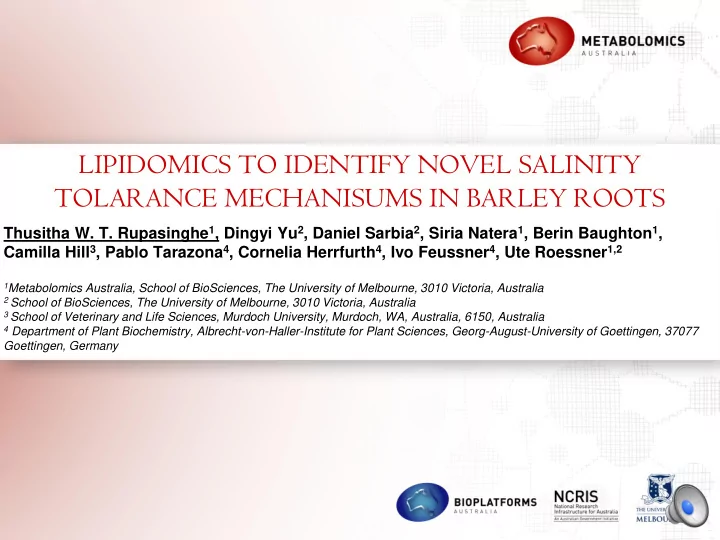

LIPIDOMICS TO IDENTIFY NOVEL SALINITY TOLARANCE MECHANISUMS IN BARLEY ROOTS TITLE Thusitha W. T. Rupasinghe 1 , Dingyi Yu 2 , Daniel Sarbia 2 , Siria Natera 1 , Berin Baughton 1 , Camilla Hill 3 , Pablo Tarazona 4 , Cornelia Herrfurth 4 , Ivo Feussner 4 , Ute Roessner 1,2 1 Metabolomics Australia, School of BioSciences, The University of Melbourne, 3010 Victoria, Australia 2 School of BioSciences, The University of Melbourne, 3010 Victoria, Australia 3 School of Veterinary and Life Sciences, Murdoch University, Murdoch, WA, Australia, 6150, Australia 4 Department of Plant Biochemistry, Albrecht-von-Haller-Institute for Plant Sciences, Georg-August-University of Goettingen, 37077 Goettingen, Germany
Salinity in Australia Valley of Salt Salinity in the Western Australian wheat-belt near Bruce Reference: CSIRO ScienceImage 2
Abiotic stress affects agricultural productivity in Australia? • Australian wheat belt significantly affected by salinity • Barely is the second highest grain produced in Australia • In danger: Australian wheat and Barley exports worth ~ $6 billion p.a. Rengasamy (2002) Aust. J. Exp. Agric. 42: 351-361 3
Effect of salt stress on plants Roy et al, 2012 4
Effect of salt stress on roots 1 cm 1 cm Control Salt Clipper- Commercial Australian cultivar (tolerant to salt -better root growth under salt stress) Sahara - North African landrace (sensitive to salt -reduced root growth under salt stress) 5
Study Design Barley Cultivars: Clipper and Sahara Growth and Treatment on Agar Plates Root Tissue Harvest (3 Zones: Root Cap, Elongation and Maturation Zone) Lipid and FA Analysis Data Analysis and Statistics Data Integration and Biological Interpretation
Lipidomics approach Homogenization Tissue of interest Quench Lipid analysis Data interpretation 7
Lipid analysis workflow Sahara plant Clipper plant Sahara plant Clipper plant (Salt-treated), n=5 (Control), n=5 (Control), n=5 (Salt-treated), n=5 Root slid preparation Total lipid for imaging extraction (TL) Lipidomics IMS LC-MS GC-MS
Targeted Fatty Acid Analysis – GC-MS C- Clipper S - Sahara Z – zone 0 - no salt 1- salt treated
Targeted Lipid Analysis – LC-MS Clipper and Sahara (zone 1+2 +3) PCA & heat map for the targeted phospholipid data
Total lipid analysis in salt treated roots – Untargetted & targeted LC-MS analysis Natera et al, 2016, Funct Plant Biol
Oxidative defence metabolites induced by salinity stress in roots of Salicornia herbacea Oxylipin metabolism in response to stress in plants Ref: Seung Jae Leea, Journal of Plant Physiology 206 (2016) Ref: Gregg Howe and Anthony L Schimiller -Current Opinion in Plant Biology, 2002, 5(3) 230-236
Oxidized lipid analysis in salt treated Barley roots (Clipper- tolerant to salt stress) PCA & heat map for the targeted oxidised lipid data 13
Oxidized lipid analysis in salt treated Barley roots (Clipper- tolerant to salt stress) 14
Oxylipin profiles in salt treated Barley roots (Clipper- tolerant to salt stress) Ivo Feussner and Cornelia Herrfurth (Goettingen Uni)- Germany
Spatial distribution of lipid in salt treated Barley roots (Clipper- salt treated for 48 hours – positive mode IMS) Control Control 150 mM NaCl 150 mM NaCl OPDA PE(36:5) PE(36:5) Control Control 150 mM NaCl 150 mM NaCl OPDA PE(38:5) PC(38:5)
Spatial distribution of lipid in salt treated Barley roots (Clipper- salt treated for 48 hours – positive mode IMS) Control Control 150 mM NaCl 150 mM NaCl PC(36:6) PC(34:0) Control Control 150 mM NaCl 150 mM NaCl PC(36:5) PC(38:5)
Summary • Lipid profile of barley roots shows significant difference between Clipper and Sahara cultivars. • The Barley species tolerant to salt stress shows, PUFA contains PC and PE lipids and HPOD keto and HPOT keto oxidised lipids are increased and HOT and HOD oxidised lipids are decreased as response to salt stress. • Oxidised lipids and oxylipins plays an important role of the defence mechanism against the salinity in Barley. • Pathway mapping of oxidised lipid biosynthesis is important to investigate to understand further insight of the defence mechanism in Barely response to salt stress.
Acknowledgements Roessner lab Prof Ute Roessner Dingyi Yu (PhD student) Daniel Sarbia (PhD student) Metabolomics Australia Dr Siria Natera Nirupama Jayasinghe Murdoch University Dr Camilla Hill Collaborators (Georg-August-Universität Göttingen) Prof Ivo Feussner Dr Pablo Tarazona Thank You & Questions?? Dr Cornelia Herrfurth 19
Recommend
More recommend